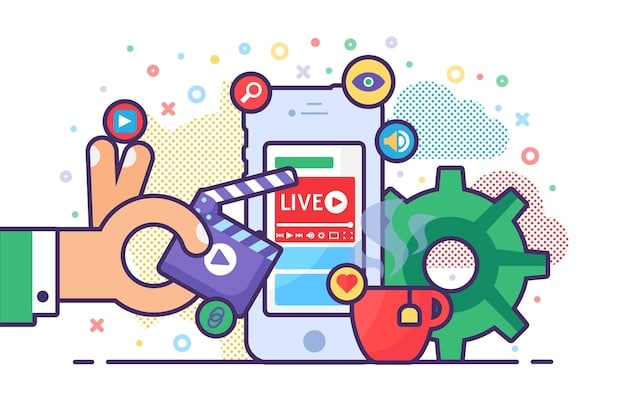Navigating the Dark Side of Virality: Trolling and Harassment Online

Anúncios
The Dark Side of Virality explores how online harassment and trolling can emerge from viral content, impacting individuals and communities, and offers strategies for mitigating these negative effects.
Anúncios
Going viral can feel like hitting the jackpot, but the intense spotlight can also reveal
Understanding the Viral Phenomenon
What makes something go viral? The answer is multifaceted, involving a blend of luck, timing, and content resonance. However, virality isn’t always a positive experience.
Anúncios
Understanding the mechanics of virality is crucial. It’s not just about creating something popular; it’s about understanding the potential consequences and how to deal with them.
The Anatomy of Viral Content
Viral content often possesses certain characteristics that make it highly shareable. Let’s examine some key elements:
- Emotional Appeal: Content that evokes strong emotions, whether positive or negative, tends to spread quickly.
- Relatability: People share content that they can identify with or that reflects their own experiences.
- Novelty: Unique and unexpected content often captures attention and encourages sharing.
- Social Currency: Sharing content that makes the sharer look good or knowledgeable can drive virality.
Virality can be a powerful tool for spreading messages and building communities, but it also comes with risks. Understanding these risks is the first step in mitigating their impact. The speed and reach of viral content can amplify negativity, making it essential to have strategies in place to deal with potential harassment and trolling.

The Rise of Online Harassment and Trolling
The anonymity and distance afforded by the internet can embolden individuals to engage in behaviors they might avoid in face-to-face interactions. This often leads to online harassment and trolling, especially when content goes viral.
Online harassment and trolling can take many forms, from name-calling and insults to more severe threats and doxing. Understanding these different types is crucial for developing effective responses.
Types of Online Harassment
It’s important to recognize the various forms that online harassment can take. Here are a few common examples:
- Cyberbullying: Using electronic communication to bully or harass an individual.
- Doxing: Publicly revealing someone’s personal information without their consent.
- Hate Speech: Attacking a person or group based on attributes such as race, religion, or gender.
- Online Stalking: Repeatedly harassing or threatening someone online, causing fear for their safety.
The impact of online harassment can be profound, leading to anxiety, depression, and even suicidal thoughts. The constant barrage of negativity can create a hostile environment, making it difficult for individuals to participate in online communities. Recognizing the signs of online harassment and having strategies to deal with it are essential for protecting mental health and fostering a positive online environment.
Psychological Impact of Online Abuse
The psychological effects of online abuse can be devastating. Victims often experience anxiety, depression, and a sense of isolation. The constant exposure to negativity can erode self-esteem and create a feeling of helplessness.
Understanding the psychological impact of online abuse is crucial for providing support and developing effective coping strategies. The mental health consequences can be long-lasting, affecting an individual’s ability to trust and engage in social interactions.
Long-Term Effects on Mental Health
The long-term effects of online abuse can be particularly damaging. Some of these effects include:
- Post-Traumatic Stress Disorder (PTSD): Exposure to severe online harassment can trigger symptoms of PTSD.
- Social Anxiety: Fear of future online attacks can lead to avoidance of social interactions.
- Depression: Constant negativity and feelings of helplessness can contribute to depression.
- Low Self-Esteem: Persistent criticism and insults can erode self-worth.
Research has shown that victims of online harassment are more likely to experience mental health issues than those who have not been targeted. The anonymity and ubiquity of the internet can exacerbate these effects, making it difficult for victims to escape the abuse. It’s important to create a culture of empathy and support for victims of online harassment, providing resources and encouragement to seek help.

Strategies for Dealing with Trolling and Harassment
There are several strategies that individuals and communities can use to deal with trolling and harassment. These range from simple blocking and reporting to more proactive measures aimed at creating a positive online environment.
It’s essential to develop a comprehensive approach that combines individual actions with community-level interventions. This includes educating users about online safety, providing resources for reporting abuse, and fostering a culture of respect and empathy.
Practical Steps to Take
Here are some practical steps that individuals can take to deal with trolling and harassment:
- Block and Report: Use the blocking and reporting tools available on social media platforms to remove abusive content and users.
- Document Everything: Keep records of all instances of harassment, including screenshots and timestamps.
- Adjust Privacy Settings: Limit the amount of personal information that is publicly available.
- Seek Support: Talk to friends, family, or a mental health professional about the experience.
In addition to these individual actions, it’s important to work with online communities and platforms to address the root causes of online harassment. This includes advocating for stronger moderation policies, promoting digital literacy, and fostering a culture of respect and empathy. By working together, we can create a safer and more positive online environment for everyone.
The Role of Social Media Platforms
Social media platforms have a crucial role to play in combating online harassment. They need to implement effective moderation policies, provide clear reporting mechanisms, and take swift action against abusers.
Many platforms are beginning to take steps in the right direction, but there is still much work to be done. Transparency and accountability are essential for building trust and ensuring that platforms are taking their responsibilities seriously.
Platform Accountability and Responsibility
Social media platforms must be held accountable for the content that is shared on their sites. This includes:
- Investing in Moderation: Hiring skilled moderators who can quickly identify and remove abusive content.
- Improving Reporting Mechanisms: Making it easier for users to report harassment and providing timely responses.
- Enforcing Policies: Consistently enforcing community guidelines and taking action against repeat offenders.
- Promoting Transparency: Being open about moderation policies and actions taken against abusive users.
Social media platforms have a responsibility to create a safe and welcoming environment for all users. This includes investing in technology and personnel to combat online harassment, as well as working with experts to develop effective strategies for preventing and responding to abuse. It’s also important for platforms to be transparent about their moderation policies and to provide users with clear information about how to report harassment. By taking these steps, social media platforms can help to create a more positive and inclusive online environment.
Building a Positive Online Community
Creating a positive online community requires a collective effort. It involves promoting empathy, fostering respect, and encouraging responsible online behavior.
Education is key. By teaching people how to be responsible digital citizens, we can create a culture that rejects online harassment and promotes positive interactions. This includes teaching children and adults about online safety, digital etiquette, and the importance of empathy.
Steps to Foster a Better Online Culture
Here are some steps that individuals and communities can take to build a better online culture:
- Promote Empathy: Encourage people to consider the impact of their words and actions on others.
- Foster Respect: Create a culture of respect and inclusivity, where everyone feels valued and appreciated.
- Encourage Responsible Behavior: Teach people how to be responsible digital citizens and to report online harassment.
- Lead by Example: Model positive online behavior and speak out against online harassment.
Building a positive online community requires ongoing effort and commitment. It’s not enough to simply implement policies and procedures; we must also create a culture of empathy, respect, and responsibility. This includes teaching people how to communicate effectively online, how to resolve conflicts peacefully, and how to support one another in times of need. By working together, we can create online communities that are safe, welcoming, and empowering for everyone.
| Key Point | Brief Description |
|---|---|
| 📢 Virality Risks | Virality amplifies negative content, increasing exposure to harassment. |
| 🛡️ Dealing Strategies | Blocking, reporting, and adjusting privacy settings are essential. |
| 🌐 Platform Role | Platforms should enforce policies and improve moderation to protect users. |
| ❤️ Community | Building a positive community promotes empathy and responsible behavior. |
Frequently Asked Questions
▼
Online harassment includes any form of unwanted, aggressive behavior conducted using electronic means. It can range from insulting comments to threats and stalking, causing victims distress.
▼
Protecting yourself involves adjusting privacy settings, blocking suspicious accounts, and avoiding engaging with trolls. Documenting instances of harassment can also be beneficial if you need to report abuse.
▼
Platforms should invest in advanced moderation tools, enforce stricter policies against abusive content, and provide quick response systems for reported incidents to create a safer environment.
▼
Psychological effects can include anxiety, depression, PTSD, and decreased self-esteem. The constant exposure to negativity can significantly impact mental health and well-being of the victim.
▼
Communities can encourage a positive environment by promoting empathy, respect, and responsible online behavior. Education on digital etiquette and bystander intervention can further support a healthy online culture.
Conclusion
Navigating





